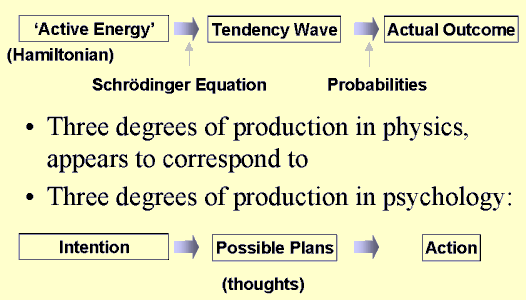|
| |
Analogies between Quantum and Mental Processes
I am here going to draw analogies between mental and quantum phenomena
that I have previously written about. If
you already know something about minds, these may help you understand quantum
physics! Some of these have been pointed out by Bohm (1951, § 8.27ff)
and more recently by Jahn & Dunne (1986) and Zohar (1990) (although
perhaps understood in different ways: see later discussion).
Jahn and Zohar have tended to concentrate on the analogies between mental
structures, and the structure of matter entailed by quantum mechanics.
They look at analogies between, for example, minds and quantum systems,
and then especially analogies between how minds interact and how quantum
systems interact. I will be looking rather at analogies between individual
mental processes within minds and individual quantum processes. I believe
that only when we understand the elementary processes of both the mind
and quantum matter, can we more completely understand complex systems of
either kind.
In order to make analogies with quantum physics, I am going to use the
propensity
interpretation developed above. I am also going to assume a view of
mind that is in part phenomenological (after Bergson especially), and in
part influenced by (a few of) the problems of cognitive
modelling and the recognition of the complexity of even apparently
elementary mental processes. On this basis, we can draw analogies between
the fundamental processes of quantum physics and the fundamental processes
of mental activity:

|
Quantum Processes
|
Mental Processes
|
|
Summary
|
|
| Quantum processes are driven by the energy operator (the Hamiltonian) |
Mental processes are driven my intentions and desires |
| The wave function describes the propensities for possible outcomes
before actual selection made. |
Mental processes often have/are forms of propensities for possible
outcomes before deciding. |
| Actual selections eleminate alternate histories |
Actual decisions eliminate alternative possible worlds. |
|
More detail
|
|
| Quantum objects do not evolve uniformly in time, but as a succession
of 'states' between intermittently 'actualising' to one outcome of a certain
range. |
Mental entities do not evolve uniformly in time, but in a succession
of 'specious presents' between intermittent changes of state |
| The state of a quantum object is not a static configuration of elements,
but a 'state of propensity' for possible virtual proceses, possible interactions
and possible actual (observable) outcomes. |
The state of a mind is not static, but more a 'state of propensity':
it is a continual recollection of past events and continual anticipation
of future possibilities. |
| The state of a quantum object may be described by a wave function distributed
is space, but this does not mean that the quantum object is composed of
elements so distributed. Rather, it has a basic unity in that it will always
act as a whole. These spatial distributions merely describe where it can
actualise. |
The state of a mind has a similar basic unity. The thoughts in the
mind may be diverse, and each may implicitly contain diverse elements (usually
the better for doing so), but if they lead to action these diverse elements
were merely describing where the mind could have operated. |
| The driving impetus of quantum processes are not external, but the
very propensities of which quantum objects are forms. These propensities
operate according to the (spatiotemporal) circumstantial relations with
other objects. |
The driving motivation of mental processes are not external, but the
very motivational loves which underly all psychic activities. These motivations
operate according to the circumstances at each time. |
| Behind the apparently continuous evolution of the Schrödinger's
equation, there is a progressive multitude of 'virtual events' whose operation
forms the potential term in Schrödinger's equation. |
As a consequence of cognitive simulation work, we know that the operation
of even seemingly simple events such as the perception of solid objects
must involve 'behind the scenes' a great deal of information processing
which is not apparent in the act of perception itself. |
These analogies are only suggestive. Now doubt we could also find analogies
between minds and classical mechanics, but in later
work we will begin to see the reasons for the above mind-quantum analogies. |